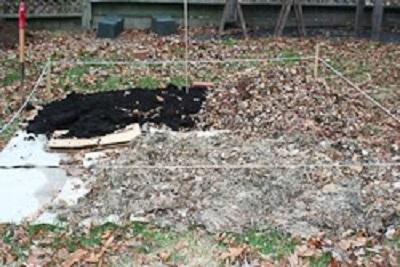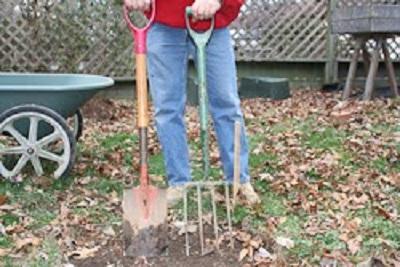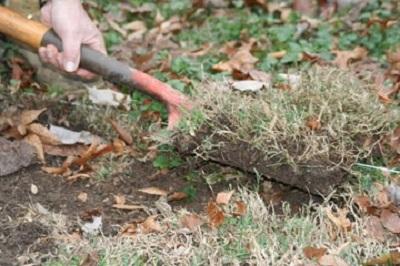Start an in-ground garden by preparing the soil
Lawn (turfgrass) removal methods
For the successful establishment of a garden or lawn alternatives, you may need to smother and kill or remove an existing layer of turfgrass. Physical methods of turf removal can work very well. Diligence is the key to removing persistent grasses and weeds, no matter what method you choose. Several options for turf removal are described below.
No-till methods
Use cardboard, newspaper, or weed barrier material to smother and kill the grass.
You can kill the grass by covering it with several layers of newspaper or one layer of overlapping pieces of unwaxed cardboard. Cover that with a 2-4 inch layer of compost. Prior to adding the compost, you can also layer on shredded tree leaves and/or grass clippings (no herbicides) if they are available. This is especially helpful if the soil is high in clay and/or the topsoil is thin. This is best done in the fall but the method can also work in early spring. It may take 6-8 weeks for the turfgrass to die and begin to decompose, depending on the temperature and weather conditions. You can plant seeds or transplants directly into the compost layer.



and shredded leaf mixture (bottom)
You also can cover sunny areas with a reusable tarp or woven fabric weed barrier, which will effectively smother the vegetation underneath. Black plastic also can be used but it is not recyclable. Secure the cover with landscape fabric pins or use bricks, boards, or stones to weigh down the edges of the material and hold it in place. Remove the cover once the turf has died (two to three months), and then apply a 2-4 inch layer of compost. After that, you can either plant seeds or plants into the compost or mix the compost and dead turf with a garden fork or shovel, rake it smooth, and start planting!
Slice and loosen method
For small areas, less than 100 square feet.
Slide a garden spade (flat, rectangular blade) through the top 1-2 inches of sod and soil, parallel with the ground. Sod contains valuable topsoil and organic matter and should not be thrown out. Instead, turn it over next to the garden area to dry and kill the roots. After the sod turns completely brown it should be mixed back into the soil.


While you wait for the sod to die, spread a 2-4 inch layer of compost over the garden site. Before and after spreading the compost you can use a garden fork to loosen the subsoil. Insert the fork and rock it gently back and forth to the subsoil. This will improve the movement of air, water, roots and soil organisms through the soil. Then spread the dead sod and topsoil you removed and mix it all together. Plant and mulch the area soon after to minimize weeds.

Loosening subsoil with a garden fork
For areas larger than 100 square feet, you may want to rent a sod cutter from your local hardware store to make this task easier. A sod cutter will remove strips of sod, which you can then flip over and leave in place. Sod contains valuable topsoil and organic matter and should not be thrown out. Turn it over to dry out and kill the roots. You also can preserve all of the sod/topsoil slice by laying the sliced strips on a tarp or on weed barrier material. Covering the overturned sod with the same material will hasten sod death. After the sod turns completely brown it should be mixed back into the soil. Sod can be smothered and killed and then turned under with a powerful rototiller. This brings weed seeds to the surface to germinate so be prepared to plant, mulch, and manage weeds.
Soil testing should be the first step when you convert a lawn for another garden purpose. This is especially important if a pH adjustment is needed.